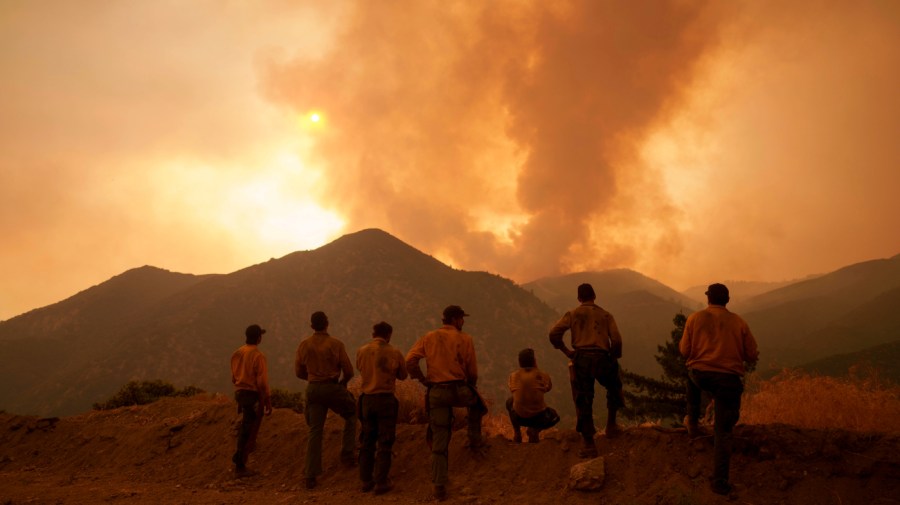
As the world stands at the precipice, with the climate clock ticking louder every day, we’ve been dealt another devastating blow: Donald Trump is president-elect. His incoming administration casts a long shadow over every step we’ve fought so hard to take on climate action.
For the blue states, every progressive municipality and every sector of society that believes in science, responsibility and the sanctity of our planet, this is a rallying cry. We must unite, pull together and refuse to allow our hard-won progress to be unraveled.
Let’s not mince words: The climate crisis is real and accelerating. The stakes could not be higher. Global greenhouse gas emissions, already at record highs, have risen to a staggering 57 billion tons of carbon dioxide in 2023.
The planet just experienced its second-warmest September on record, and scientists say 2024 is nearly certain to break every previous temperature record. We’re already feeling the burn with extreme weather events — unprecedented wildfires, hurricanes and heatwaves — punishing communities across the globe.
These events aren’t anomalies — they are warnings. If we continue down this path, global temperatures could rise by a catastrophic 3 degrees Celsius by the century’s end, unleashing a world of suffering beyond anything we’ve ever known.
Inaction isn’t an option, especially not now. Blue states, cities, private companies, nonprofits — every one of us must step up as the vanguard of climate resilience. California, New York, Oregon and Washington — our progress cannot be derailed by federal inaction or denial.
This is a moment for states to double down on clean energy policies, invest even more in renewable infrastructure and forge stronger alliances with NGOs and the private sector. We know the solutions: solar, wind, battery storage, carbon sequestration.
The International Energy Agency projects that global electricity generation from solar alone could quadruple by 2030. This growth in clean energy isn’t just possible — it’s inevitable, if we keep pushing.
The consequences of failing to act are devastating. Over a billion people could be displaced by 2050 due to droughts, rising seas and heatwaves.
Water scarcity is already looming, with demand for freshwater on track to outstrip supply by 40 percent by the decade’s end. One-quarter of the world’s crops are grown in highly stressed areas, where water is either too scarce or unreliable to sustain food production.
The result? Food insecurity on an unprecedented scale, compounded by social inequality, with those in under-resourced communities bearing the brunt.
Meanwhile, our planet’s ability to store carbon is collapsing. Forests, once powerful carbon sinks, are succumbing to wildfires and extreme heat, while deforestation eats away at what remains.
Since 2001, forest fires have increased carbon emissions from burning woodlands by 60 percent, wiping out millions of acres of precious forest each year. Coral reefs, which support a quarter of all marine life, are bleaching and dying en masse, victims of relentlessly warming oceans. And all of this devastation feeds back into the cycle of destruction, amplifying the very crises that caused it.
We’re not just losing species, we’re losing the foundational pillars of our biosphere. Biodiversity, which keeps our ecosystems functional and resilient, is in freefall. Human-driven extinction has already pushed the planet into what scientists call a “danger zone.”
If the Amazon reaches its tipping point and flips from a rainforest to a savanna, we lose one of the greatest stores of biodiversity and carbon on Earth. These are not mere statistics — they are existential threats to humanity’s future.
This is also a crisis of justice. Climate change is not only wreaking havoc on ecosystems but deepening social divides, particularly affecting under-resourced and marginalized communities.
The wealthiest 10 percent of the population produces nearly half of global emissions, yet it’s the poorest 50 percent who are suffering the most, facing displacement, economic devastation and threats to their health and livelihoods. Disease, drought, pollution and extreme weather amplify inequality, creating a vicious cycle where the most vulnerable suffer the most.
The fight for climate action is also a fight to redefine our economic model. The current global system, focused on endless growth and the generation of wealth for a privileged few, is unsustainable. Capitalism, as it stands, is predicated on the notion of infinite resources and endless expansion — two impossibilities on a finite planet.
We need a circular economy that recognizes the value of ecosystems, prioritizes sustainability over profits, and understands we have only one Earth. Clean energy investments, sustainable agriculture and waste reduction are not merely environmental imperatives; they are moral imperatives.
So, what will it take to forge this new path? We need an all-hands-on-deck approach.
States must pass climate laws with teeth — policies that mandate emissions cuts, support renewable energy development and hold polluters accountable. Cities and counties must implement climate-resilient infrastructure, reduce urban sprawl and embrace green buildings.
The private sector must pivot from profit-driven environmental harm to impact-driven sustainability, pouring resources into low-carbon technology and green jobs. And NGOs must advocate fiercely, applying pressure on every level of government and industry to keep climate commitments.
Every sector, organization and person has a role in this fight. The climate crisis is a shared challenge, one that transcends borders and party lines. Our work, the work of the blue states and climate advocates, cannot be undermined by political shifts.
It is a mandate from the Earth itself, a call to protect our future and the future of generations to come.
Charles Fletcher is the interim dean of the School of Ocean and Earth Science and Technology at the University of Hawaiʻi Mānoa.














